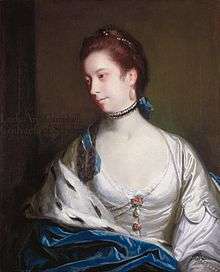William Wentworth, 2nd Earl of Strafford (1722–1791)
.jpg)
William Wentworth, 2nd Earl of Strafford (17 March 1722 – 10 March 1791), styled Viscount Wentworth until 1739 was a peer and member of the House of Lords of Great Britain.
Ancestry and career
Strafford was the only son of Thomas Wentworth, 1st Earl of Strafford (1672-1739). His paternal great-grandfather was Sir William Wentworth of Ashby Puerorum, a younger brother of Thomas Wentworth, 1st Earl of Strafford of an earlier creation. His father was a cousin of William Wentworth, 2nd Earl of Strafford, who died childless, on whose death in 1695 he became the 3rd Baron Raby. However, the Strafford fortune, with the estate of the great Jacobean house of Wentworth Woodhouse, went to a nephew of the second Earl's by marriage.
The title of Earl of Strafford was created for the third time in 1711, for Strafford's father, and thus came to him on his father's death in 1739.[1] He was also 2nd Duke of Strafford in the Jacobite Peerage. He played less of a political role than his father, although he was granted a farm of the post fines on 25 March 1756 and was appointed a deputy lieutenant of the West Riding of Yorkshire on 4 August 1757.[2]
Architect

Strafford added a neo-Palladian range to Wentworth Castle, his country house in Yorkshire, a project begun in 1759 and completed in 1764. As its principal designer, this gained him an entry in Colvin's Biographical Dictionary of British Architects.[3] [4][5] Strafford's friend Horace Walpole described this south front on 2 August 1770, as showing "the most perfect taste in architecture":[6]
| “ | If a model is sought of the most perfect taste in architecture, where grace softens dignity, and lightness attempers magnificence; where proportion removes every part from peculiar observation, and delicacy of observation recalls every part to notice; where the position is the most happy, and even the colour of the stone the most harmonious; the virtuouso should be directed to the new front of Wentworth-castle: the result of the same elegant judgement that had before distributed so many beauties over that domain, and called from wood, water, hills, prospects and buildings, a compendium of picturesque nature, improved by the chastity of art. | ” |
Marriage

In 1741, Strafford married Lady Anne Campbell (born about 1715, died 1785), the second of the five daughters of John Campbell, 2nd Duke of Argyll. The two became part of a social set which included Horace Walpole, who considered the countess to be a "vast beauty" and immortalised her in a poem which was published in 1765.[7]
When Strafford was widowed in 1785, society gossip quickly linked his name with that of Lady Louisa Stuart (1757–1851), leading Lady Diana Beauclerk to remark "So Lady Louisa Stuart is going to marry her great-grandfather, is she?"[8] However, Stuart looked on Strafford merely as an elderly uncle, and not as a suitor, and he for his part did nothing to promote such an alliance.[9]
Strafford died without issue in 1791.[10] He was succeeded by his first cousin's son, Frederick Wentworth, 3rd Earl of Strafford.
Likenesses
Portraits of Strafford include one by Sir Joshua Reynolds which was engraved as a mezzotint by James Macardell. The copy of this in the National Portrait Gallery is erroneosly described as of 'William Wentworth, 4th Earl of Strafford (1722–1791)'.[11]
Strafford's countess was also painted by Sir Joshua Reynolds.[7]
References
- ↑ "Earl of Strafford". rotherhamweb.co.uk. Retrieved 5 March 2008.
- ↑ Doyle, James William Edmund (1886). The Official Baronage of England, v. 3. London: Longmans, Green. p. 416.
- ↑ Colvin, Howard, A Biographical Dictionary of British Architects 1600–1840 (Yale University Press, 1954, now in 4th edition, ISBN 0-300-12508-9)
- ↑ Hewlings, Richard, Ripon's Forum Populi in Architectural History, Vol. 24 (1981), pp. 39–52 and 150–152
- ↑ Wentworth Castle and Stainborough Park estate online at rotherhamweb.co.uk (accessed 5 March 2008)
- ↑ Walpole, Horace, Anecdotes of painting in England, with some account of the principal artists (new edition, London, Henry G. Bohn, 1849) page 813 online at google.co.uk (accessed 5 March 2008)
- 1 2 "Anne, Countess of Strafford (c. 1715–1785)". artsmia.org. Retrieved 5 March 2008.
- ↑ Memoirs of the Argylls in the Journal of Lady Mary Coke, vol. 1, p. xlix
- ↑ Graham, Harry, [Jocelyn Henry C. Graham], A Group of Scottish Women (New York, Duffield & Co., 1908) Chapter XVIII "Lady Louisa Stuart (1757–1851)". Retrieved 29 February 2008.
- ↑ De Ruvigny, Marquis, The Jacobite Peerage, Baronetage, Knightage, and Grants of Honour (Edinburgh: T.C. & C.E. Jack, 1904, new edition by Genealogical Publishing Company, 2003, ISBN 0-8063-1716-7) p. 171
- ↑ William Wentworth, 4th Earl of Strafford (1722–1791) at npg.org.uk (accessed 1 March 2008)
| Peerage of England | ||
|---|---|---|
| Preceded by Thomas Wentworth |
Earl of Strafford 2nd creation 1739–1791 |
Succeeded by Frederick Wentworth |